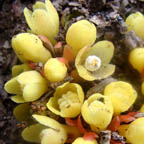
|
Cytinaceae A. Rich.
|
Photographs
Bdallophytum americanum
(= B. bambusorum). Also being spelled Bdallophyton
- Immature and mature inflorescences
and young inflorescences
emerging from excavated host root. Near Juigalpa, Nicaragua. Photo by
Job Kuijt.
- Male plant and female
plant parasitic on roots of Bursera, Centro de
Investigaciones Costeras La Mancha, Veracruz, Mexico. Photo by José G.
García-Franco.
- Photos.
Staminate and carpellate flowers. Nicaragua. Photos by Olga Martha
Montiel, voucher by Stevens (20527). Link goes to
TROPICOS.
- Bdallophytum americanum.
Infructescence. August 1990. Photo by J. Mauseth.
- Photos
Chiapas. Mexico. Link goes to Flora of the
World.
Bdallophytum caesareum
- This plant was originally published as a new genus and species, Sanguisuga
caesarea: Fernández-Alonso, J. and H. Cuadros-Villalobos. 2012. Sanguisuga,
un género nuevo neotropical de Cytinaceae y una conexión sudamericana en
la familia. Caldasia 34: 291-308. Having carefully reviewed the
manuscript, I (DLN) indicated this would better be placed in the genus Bdallophytum.
The authors did not agree, hence the publication above. In February 2018
the self-publication by Plant Gateway entitled "The Global Flora: A
practical flora to the vascular plant species of the world" came out.
Under no. 244 we read "We do not think the parasitic species found in
Colombia in 2012 morphologically differs enough from the Central
American Bdallophytum Eichler to warrant generic status." With
this short justification they then made the combination Bdallophytum
caesareum (Fern.Alonso & H.Cuadros) Byng & Christenh. It
is unfortunate that no molecular data were obtained to support this
taxonomic decision.
- Photos of the plant can be found HERE
on PhytoImages.
Cytinus baronii
- Photo.
Flowers in tight inflorescence emerging from host (Croton)
bark. Masoala peninsula, West coast, Andranobe, Madagascar.
Photo by S. Malcomber (voucher 2804A). Link
goes to TROPICOS.
Cytinus capensis
- Photos
by Nina Hobbhan. Link goes to
Biodiversity Explorer: The Web of Life in Southern Africa.
- Old flowers, forming fruits,
growing at the base of host plant, Diosma hirsuta (Rutaceae).
South Africa. Photo from J. Visser (1981), "South African Parasitic
Flowering Plants."
- Inflorescence. Portions of plant
exposed to light become colored. South Africa. Photo from J. Visser
(1981), "South African Parasitic Flowering Plants."
Cytinus hypocistis
- Plant parasitic on Cistus
ladenifer, Spain. Photograph by Iñigo Sanchez.
- Plant parasitic on Cistus,
Spain. Photograph by Peter Phillipson.
- Plants with flower buds
and plants in flower. Fango River,
Corsica, France. From Plant
Image Gallery by Thomas Schoepke.
- Close-up of flowers.
Spain. Photo by Willem Meijer.
- Photos
from everyone. Link goes to Flickr.
- Photos.
Plant in flower. Spain, Almeria Cabo de Gata. Link
goes to Flora of the World.
Cytinus ruber
Cytinus sanguineus
- Photos
of male plants (this species is dioecious). This species is considered
by some to be conspecific with C. capensis (hence C.
sanguineus a synonym of C. capensis). Photos by
Meredith Cosgrove in South Africa. Link
goes to PhytoImages.
- Flowers emerging from host
roots. South Africa. Photo from J. Visser (1981), "South African
Parasitic Flowering Plants."
- Flowers emerging in a series
along the host root. Photo from J. Visser (1981), "South African
Parasitic Flowering Plants."
- Close-up of interior of flower.
Birds are usually implicated as the main pollinators owing to the bright
red coloration and the presence of floral cavities (each containing
ca.300 µl of nectar) surrounded by glandular hairs on the yellow rim.
Visser hypothesizes that ants may also assist in pollination. Photo from
J. Visser (1981), "South African Parasitic Flowering Plants."
- One view and a second
of the fruits. At the foot of dunes on the beach near Sedgefield
(between George and Knysna), South Africa. "SOPHY" : Banque de
données Botaniques et Ecologiques. Présentation de photographies de
plantes d’Afrique du sud et Namibie. Photo by Henry Brisse.
Cytinus visseri
- Flowers. Plant (at this time
unnamed) from Northern Transvaal. Photo from J. Visser (1981), "South
African Parasitic Flowering Plants."
- Habit of plant. Photo 1
and photo2. This new
species, recently named by Smithies and Burgoyne in honor of Dr.
JohannVisser. Long Tom Pass, Mpumalanga, South Africa. Photos by Mark
Mort.
- Dissected flowers, on light
background and dark
background. Same location as above. Photos by Mark Mort.
- The flowers of Cytinus visseri are visited by elephant
shrews, guided their by the smell. The volatile compounds are being
explored by Stefan Dötteri at the University of Bayreuth. His work is
described on this PAGE
(in German); check out the video near the bottom of the page showing the
shrew pollinating Cytinus!
Cytinus species
novum (possibly)
- Unopened flower bud and opened
flower bud. Madagascar, Prov. Antsiranana, Masoala Peninsula.
Photograph by George E. Schatz [no. 3697, Schatz et al. 17 Nov 1996].
- Female flower. This is
possibly the same species as Schatz 3697 (above). Marojejy National
Park, Madagascar. Photo by Erik Patel.
Phylogeny
The first study to show Cytinaceae were
related to Malvales was Nickrent et al. (2004). For
a PDF file of this article, click
HERE.
A later study showed that Cytinaceae are
related to Muntingiaceae in Malvales. This was reported in Nickrent
(2007). For a
PDF file of this article, click
HERE.

Last updated:



